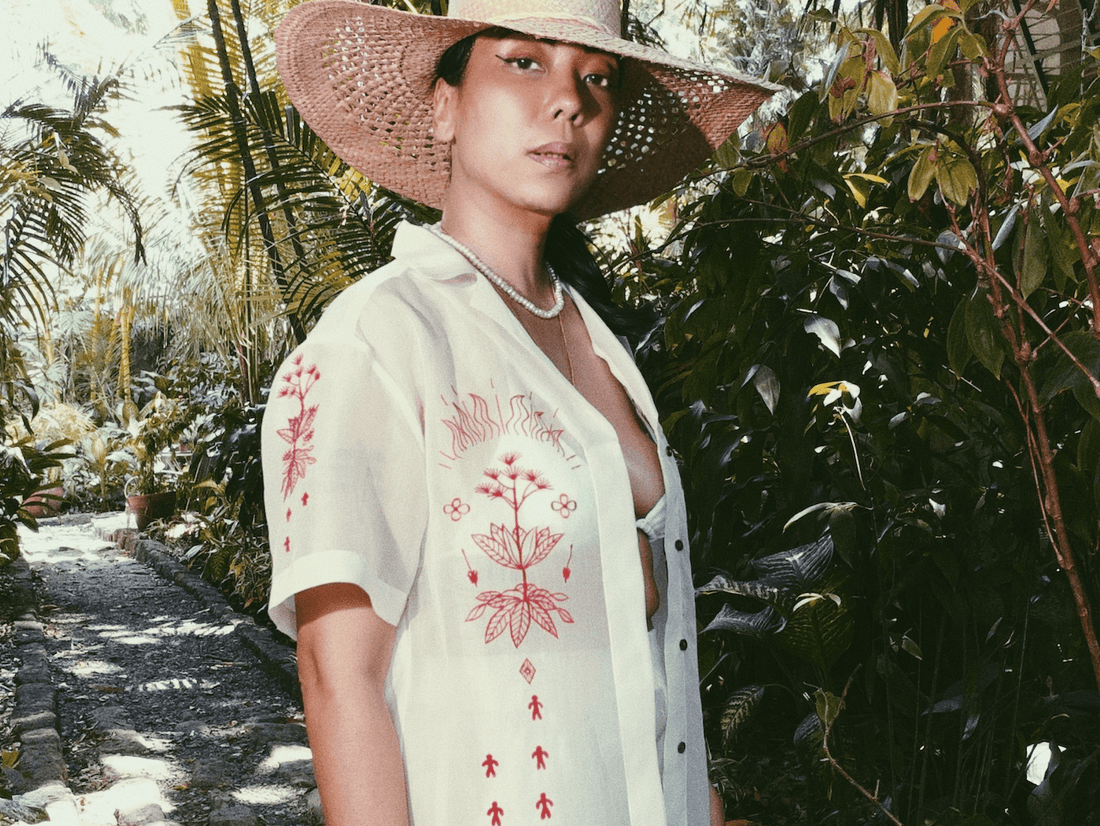The Power of the Dita Tree: A Plant Meditation
By Amanda L. Andrei, Guest Writer for VINTA Gallery
Dita. Alipawen. Tangitang. Saptaparni. Blackboard tree. Bitterbark. Devil’s tree.
Here are only a handful of names in Tagalog, Ilokano, Bisaya, Bengali, and English of the alluring, protective Alstonia scholaris, a medicinal yet highly toxic tree native to China, India, Australia, and Southeast Asia. You may remember this tree from the Kontra Katatagan Barong, its outline embroidered in bold red on white jusi fabric.
What is this paradox, the tree that kills and heals? How can it have such a musical name in one language while being marked as the devil’s own in another?
What can this tree teach us about holding our multiple identities together, our poisons and our medicine?
One of the hardest things I’ve observed about being in the diaspora is the loss of intimacy with our native plants. We don’t get to see, feel, smell, taste, hear them in the same way. We’re reduced to looking at pictures online, perhaps seeing them in a botanical garden if we’re lucky.
And while these moments of mediated contact can help reconnect us with what has been lost through displacement and migration, there’s nothing quite like experiencing our native plants in the flesh. Beyond the utility of what they give us — food, medicine, shelter, clothing — they also give us inspiration, stories, beauty, and enchantment.
Look at this gorgeous Dita Tree:
Looking at this picture, could you imagine that this tree could grow to a towering 40 meters (130 feet)? That’s almost half the size of the Statue of Liberty. Imagine that tree greeting you at dusk. Look how its glossy leaves open like hands with round fingers, how its white blossoms burst forth like tiny sparkling stars. One of its English names, “Blackboard tree,” refers to its association with scholars and intellectuals: its wood was traditionally used to make slates and blackboards for students.
Why would anyone ever call this the devil’s tree?

It would take more historical and ethnographic research to get fuller stories behind these names, but online sources offer different theories. One explanation is that the tree is marked as evil because it is poisonous to humans. Indeed, cutting into this tree’s leathery gray bark yields a thick, bitter, milky sap that can be toxic if too much is taken. In the seminal 1837 Filipiniana text Flora de Filipinas, friar and botanist Fr. Manuel Blanco recommends that the bitter sap could be used as a substitute for quinine to treat malaria as well as fevers. Most intriguingly, he also observes (as translated into English by Luis Antonio Mañeru):
“For those who are timid in drinking the decoction of its tree bark, I will counsel the stories of those curanderos (native healers) who make women drink its very sap direct from the tree as a cure for feminine sicknesses, which is a way more dangerous and ill-advised treatment…”
What a captivating image! Native women, perhaps needing relief from menstruation, menopause, fertility issues, or any range of discomfort, finding their pain alleviated and their bodies nurtured from stepping up to this tree, cutting it open, and accepting its bitter milk straight from the source. How long did they stay there, drinking the sap, surrendering their pain to the tree? Did they go at night, under the moonlight? Or perhaps during the day, when the sun could warm the tree’s sap, make it warm as it soothed these women’s bodies?

Another fascinating explanation for this tree’s reputation comes from its fragrance and association with darkness. In Satya Chaitanya’s 2019 essay Saptaparni: Enigma of the Voluptuous Devil's Tree, he provides us with an Indian perspective of the tree, how its flowers become more intoxicating “especially at night when it speaks straight to your heart.” Somehow, sensuality and the unknown became associated with the devil — you might lose your reason or sense of self at night, especially with such a sweet, arousing perfume in the air.
How might we reclaim and rethink our own sense of sensuality and mystery and how it integrates with our minds and sense of self?
Chaitanya’s musings remind us that this tree thrives in multiple lands, experiences a variety of other ecosystems, and that other cultures’ experiences and associations with this tree continue to enrich our understanding and awe of it. And this tree teaches us that we, too, have many names and identities. Powers that can be used for healing or harming. There’s clearly something about this tree that can hold beauty and danger, sensuality and intellect, while simultaneously calming our fevered bodies and protecting us from vicious diseases. It could damage us if we take too much, yet if we come to it at the right time and ask for the right amount of its substance, it could save our lives.

Here at VINTA Gallery, there’s so much deep meaning in our embroidery. What may seem like a few stark lines or a collection of orderly stitches is our efforts in capturing the essence of these plants, these entities. They’re here for you to not only feel protected, but be protected. Next time you slip on or see the Kontra Katatagan, know that it carries the essence of this magnificent tree. This embroidered image can be an invitation to commune more deeply with our roots, our native lands, and any place where our many-fingered hands stretch forth.
 Amanda L. Andrei is a playwright, literary translator, theater reviewer, and community archivist based in Los Angeles. She writes epic, irreverent plays that center the concealed, wounded places of history from the perspectives of diasporic Filipina women. To learn more about her upcoming events and offerings, join her newsletter.
Amanda L. Andrei is a playwright, literary translator, theater reviewer, and community archivist based in Los Angeles. She writes epic, irreverent plays that center the concealed, wounded places of history from the perspectives of diasporic Filipina women. To learn more about her upcoming events and offerings, join her newsletter.

